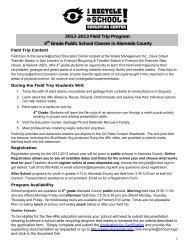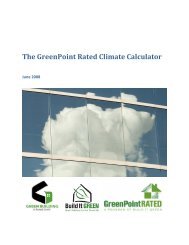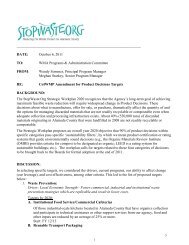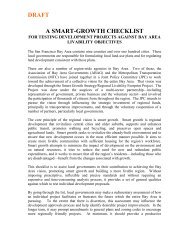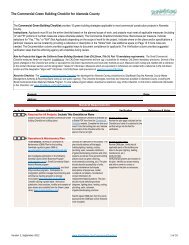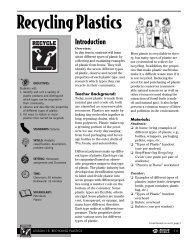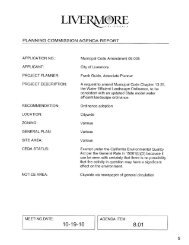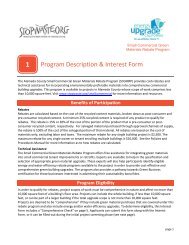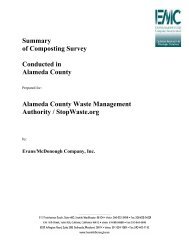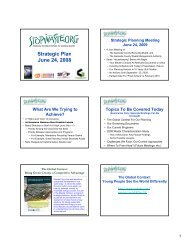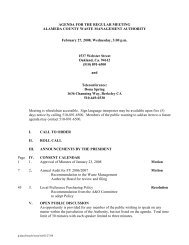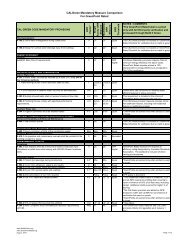Bay-Friendly Landscaping Principles and Practices - StopWaste.org
Bay-Friendly Landscaping Principles and Practices - StopWaste.org
Bay-Friendly Landscaping Principles and Practices - StopWaste.org
Create successful ePaper yourself
Turn your PDF publications into a flip-book with our unique Google optimized e-Paper software.
<strong>Principles</strong><br />
& <strong>Practices</strong><br />
5. Use local, natural plant<br />
communities as models<br />
Description<br />
A plant community is a relatively distinct<br />
pattern of vegetation that is found in<br />
different regions of the <strong>Bay</strong> Area. Six<br />
of these local plant communities are<br />
briefly described in next section of<br />
these guidelines. It is important to also<br />
consider that species of plants within<br />
these communities overlap <strong>and</strong> that they<br />
change over time.<br />
Applications<br />
n Learn about local plant communities.<br />
n Train yourself <strong>and</strong> your staff to<br />
recognize local plant communities <strong>and</strong><br />
to evaluate the conditions under which<br />
the plants are succeeding.<br />
n Use these communities to guide your<br />
choice in plant selection.<br />
n Plant seeds of annuals to fill in with<br />
color <strong>and</strong> greenery while slower<br />
growing perennials get established.<br />
Benefits<br />
Using the local, natural plant communities<br />
as a model allows you to work with<br />
nature to create spectacular l<strong>and</strong>scapes<br />
that can help replace what’s so often<br />
been degraded or lost.<br />
San Francisco <strong>Bay</strong> Area Natural Plant Communities<br />
Many local native species are excellent<br />
l<strong>and</strong>scape plants. You can imitate natural<br />
processes by using the plant community<br />
concept to <strong>org</strong>anize plantings. Blending<br />
the science of ecology with the practice<br />
of horticulture, you can create l<strong>and</strong>scape<br />
projects that assume some of the<br />
beautiful natural qualities of our area.<br />
If you choose plants<br />
in response to the site<br />
conditions, the new<br />
planting will probably<br />
become established<br />
easily. There will be no<br />
need for the special<br />
fertilizing, pest control,<br />
<strong>and</strong> heavy irrigation<br />
that have been so common in the past.<br />
The plants grow easily because they’re<br />
adapted to this place - they’ve lived here<br />
for thous<strong>and</strong>s of years! If you visit our<br />
<strong>Bay</strong> Area wildl<strong>and</strong>s, you will notice that<br />
a particular species might be abundant in<br />
a given area, only occasionally present in<br />
an adjacent space, <strong>and</strong> completely absent<br />
elsewhere. You may also recognize, as<br />
you move from south facing to north<br />
facing slopes or from exposed ridges<br />
to wooded canyons that certain groups<br />
of plants tend to grow together. This<br />
is because native plants have adapted<br />
over many generations to specific<br />
environmental conditions<br />
Ecologists classify these groups of<br />
plants with terms like “biotic province,”<br />
“vegetation type,” “plant community,”<br />
“plant association,” <strong>and</strong> “series.” The<br />
natural distribution of plants is very<br />
complex, with much overlapping of<br />
species, <strong>and</strong> experts disagree about the<br />
fine points of grouping <strong>and</strong> nomenclature.<br />
Here we use the term<br />
“plant community” to<br />
describe a group of<br />
plants that recurs with<br />
relative consistency,<br />
often dominated by a<br />
single species. The <strong>Bay</strong><br />
Area consists of many<br />
different places, from<br />
the cool, moist saltwater marshes close<br />
to the water to the hot <strong>and</strong> dry eastern<br />
ridges <strong>and</strong> slopes. These places support<br />
a series of distinctive plant communities<br />
— Saltwater Marsh, Freshwater Marsh,<br />
Riparian Woodl<strong>and</strong>, Coastal Str<strong>and</strong>,<br />
Coastal Prairie, Northern Coastal Scrub,<br />
Chaparral, Valley <strong>and</strong> Foothill Woodl<strong>and</strong>,<br />
Valley Grassl<strong>and</strong>, <strong>and</strong> Redwood Forest, to<br />
name a few.<br />
Following is a short list of representative<br />
species <strong>and</strong> a brief description of the<br />
most common plant communities of the<br />
<strong>Bay</strong> Area.<br />
photo: david gilmore<br />
16<br />
3



